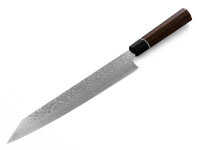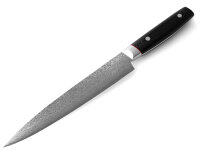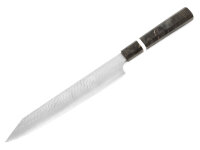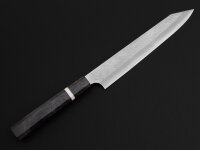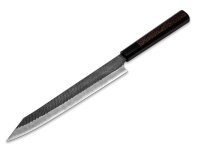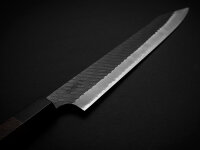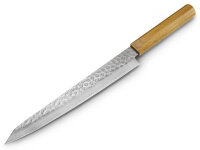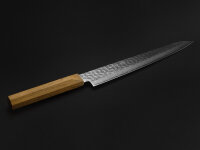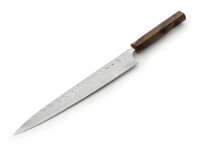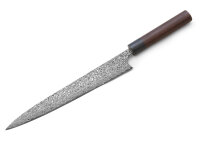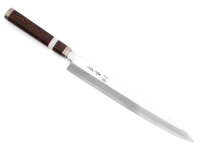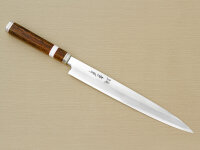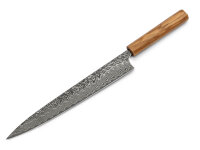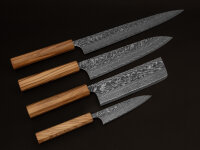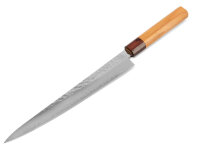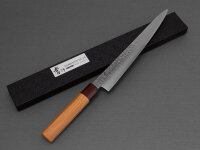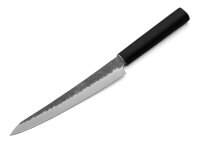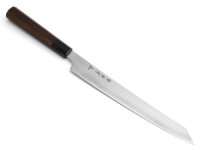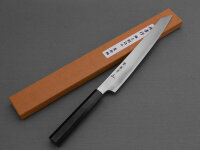
Japanese Sashimi Knives
Yanagiba, the Ideal Sashimi Knife
The best friend of a sushi chef is their Yanagiba Sashimi Knife. The Sashimi Knife is the Japanese knife for creating very fine, paper-thin slices. It is often referred to as a Sushi Knife, which somewhat limits its capabilities.
What is a Sashimi or Sushi Knife?
Technically, Sashimi is not a knife but a dish consisting mainly of thin fillets of raw fish and a delicious sauce. The knife is correctly called Yanagiba, but because it is precisely the best knife for cutting these paper-thin slices, it is also known as a Sashimi Knife or Sushi Knife. So, what is it? The Japanese filleting knife Yanagiba is slender and elegant, often sharpened to be as sharp as a razor.
The Sashimi knife is essentially a carving knife with a narrow and long blade that tapers to a very sharp point. The blade is usually over 20 cm long. The Sashimi knife, also known as the Sushi knife, is used for filleting fish and for slicing paper-thin pieces from raw fish, raw meat, as well as ham and roasts. The preparation of Sushi and Sashimi are just two practical applications for the Yanagiba fillet knife. Yes, if you had a Sashimi knife during your last Carpaccio preparation, the job would have been much easier.
What to consider when buying a Sashimi knife?
Which Sashimi knife is the best? In addition to the usual quality criteria, in our opinion, these points are particularly important:
Sharpness: The sharpness potential of the steel used should be as high as possible. High-quality Japanese Sushi knives, especially hand-forged Japanese knives, are made from steels that are much harder than European knife steels. Hardness levels of 60 to up to 67 HRC, combined with a very well-crafted blade, provide the highest sharpness potential in the realm of kitchen knives. At the same time, these steels also offer edge retention that is significantly higher than that of European stainless steel, meaning these knives stay sharp noticeably longer.
Balance: The knife should be well-balanced. Experienced knife smiths, whose chef's knives are particularly popular among professional chefs in Japan as well as in Europe, pay very close attention to ensuring their knives are well-balanced. The balance of a knife is of enormous importance, especially for users who work extensively and rapidly with the chef's knife.
Length: A Sushi chef has a lot of practice using their Sushi chef's knife, as they work with it for many hours every day. In a private kitchen, this specialized chef's knife is used less frequently. The more experienced the cook is with the Sushi knife, the longer it can be. In our view, the Sashimi knife for private use should not be too long, but to fully utilize the strengths of the Sushi knife, the blade should be over 200 mm long.
Finish: The right Sashimi or Sushi knife is very sharp, well-balanced, and has a sufficiently long blade. The finish of the blade of a Japanese Sushi knife brings additional advantages compared to a stainless steel fillet knife: fine fillets or slices do not stick to the blade or stick significantly less. For a very fast-working Sushi chef, this is a significant advantage, but even every home cook will quickly come to appreciate this feature, especially when preparing Sushi. Some chef's knives have a hollow ground or a granton edge to counter this phenomenon. However, these "anti-stick measures" often weaken the blade. Hand-forged kitchen knives from Japan address this issue with a blade finish such as a hammered finish, a bronzed blade, Kuroshiage, or Pearl Skin (Nashiji) finish. All these kitchen knife surfaces have a highly effective anti-stick effect.
Slicing Techniques - the Domain of the Yanagiba
Whether it's thin slices for Sushi, Sashimi, Carpaccio from ham, or a perfect fillet from a larger fish: only the skilled, slicing cut produces results that impress. To execute this slicing cut perfectly requires some practice. And a high-quality Japanese Yanagiba, because this fillet knife has everything necessary to convince you and your guests. Highest sharpness, a long, slender blade, and an effective anti-stick effect. Even amateur cooks can achieve professional results with this Sushi knife after just a few practice sessions.
Sushi Knives at Oryoki
Oryoki offers the following chef's knives that are very suitable for preparing Sushi, Sashimi, Carpaccio, and for finely slicing roasts and hams, as well as for filleting fish. An overview:
- Fillet Knife, Sushi Knife Yanagiba Kuroshiage, blade length approx. 24 cm. An excellent knife by Shibata Takyuki with Kuroshiage Finish. Long, robust, and sharp. Made from Aogami, blue paper steel. Not stainless.
- Sushi Knife Yanagiba Yamato: Blade length approx. 20 cm. An affordable entry into the world of hand-forged, Japanese Sushi knives. Cutting core made of carbon steel AUS-8, 3 layers of Damascus. A high-quality Sushi knife with a hammered finish.
- Damascus Knife NON Sujihiki: Tsuchime, blade length approx. 23.5 cm. This knife is double-sided sharpened. Cutting core made of VG10 steel. Very beautiful knife with a hammered finish.
- Damascus Knife Sujihiki: Nigara Hamano, blade length 22.5cm. This double-sided sharpened Yanagiba is an ideal tool for processing Sushi and Sashimi. The blade with a cutting core made of SPG2 steel is coated with Japanese stainless steel and remains rust-free.

